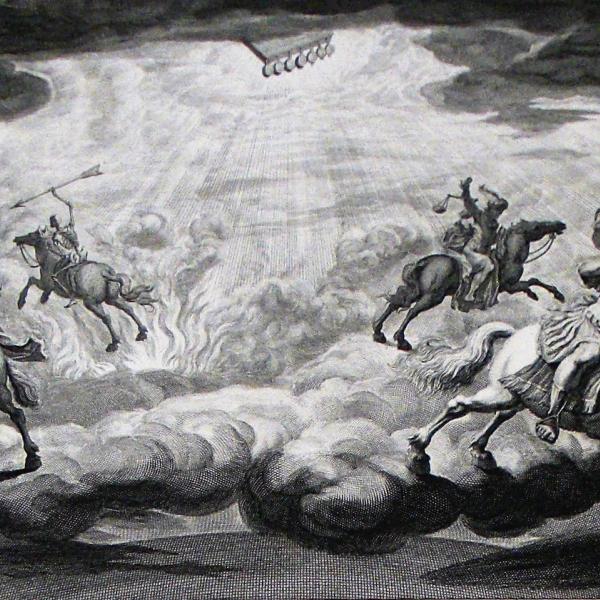William Shakespeare wrote a number of strong and memorable female characters like Kate in The Taming of the Shrew and Cleopatra of Antony and Cleopatra, but would it be fair to call him a feminist? Not really, says our guest Jami Ake, assistant dean and senior lecturer in Women, Gender, and Sexuality Studies and the Interdisciplinary Project in the Humanities at Washington University in St. Louis. She explains why questions of gender and power were prominent in early modern England society and theater and examines the range of roles women take on in Shakespeare's plays.
Transcript:
Rebecca King: Thanks for listening to Hold That Thought. I’m Rebecca King, and today we are looking at gender and the battle between the sexes in Shakespeare’s work with Jami Ake. Jami is an assistant dean and senior lecturer in Women, Gender, and Sexuality Studies and The Interdisciplinary Project in the Humanities at Washington University in St. Louis. And she says that questions about gender were quite prominent in England in the early modern period both in the larger society and in theatre itself.
Jami Ake: So one hand, you have Queen Elizabeth on the throne, which is creating all kinds of anxieties about succession and what does it mean to have a virgin queen in charge of a very patriarchal society and trying to figure out how to negotiate female power with ultimately a very dominate ideology of “men are in charge.” And in the theatre, England was unique in its insistence that female parts be played by adolescent boys or apprentices. We tend to think, as I did in high school, “Well that’s just the way it was.” But it wasn’t that way in Spain, and it wasn’t that way in France. So we have to ask those questions about what was going on in England at the time that would make it so anxiety producing to have actual women playing women so much so that that was worse than boys playing women’s parts and behaving in ways that women are supposed to behave on stage. So what does it mean to talk about imagining, say, female agency or female eroticism when there are in fact no female bodies up there? What does it mean? It is too easy, I think, to say, “Well, it’s a male writer, so we can’t take any of this seriously,” or “It is all somehow parody.” Shakespeare seems to be someone who is taking a lot of the dynamics incredibly seriously from different perspectives, and how do you do that on this very weird stage of cross-dressing? And then, of course, within the plays, how many times do you see the girls playing the boys? So you have the male actors playing the female characters who then dress as boys or young men and then go off into a forest and pair up nicely in the end. What does it mean about the instability of gender as a category?
RK: Aside from the fluidity of gender on the stage, Shakespeare also takes on questions of power, virtue, and gender stereotypes within the English patriarchy in some of his plays. One of the most famous examples of this battle between the sexes is of course The Taming of the Shrew, in which we see his classic couple of potential lovers where the man and woman bicker more than anything else, matching each other wit for wit. If you are unfamiliar with the plot, a man named Petruchio is challenged with “taming” the famously headstrong and, quote, “shrewish” Katherine so that other suitors may court her younger, beautiful sister, Bianca, who may only marry once her older sister has done so. Professor Ake explains how one Shakespeare’s original and rather violent source texts for the play is subverted in his own rendition.
JA: There’s the source story—one of them—for Taming is a story where a husband to punish his wife actually puts her inside a horses skin and beats her. This is the stuff of farce, but that is what is going to tame her; it is a sort of literal and physical beating, and it works. She has to promise not to be disobedient before he lets her out of the salted hide of the horse or whatever. All throughout Taming of the Shrew, you have this constant animal imagery and domestication imagery that’s right below the surface most of the time, including the scene where Katherine’s getting to Petruchio’s other house and Gremio is talking about how the horse and Katherine—one of them has a bridal, and it’s not clear if it is Katherine or the horse. You can see these source materials emerging from behind, but at same time, Petruchio never hits Katherine physically in the course of the play. Petruchio hits a lot of people; Petruchio gets hit. Katherine hits people; Katherine assaults people all over place. But he never hurts her. So you have this question that’s looming taming a shrew: what does it mean to do this and not include the easy physical violence that you could put in theatre and that was really quite captivating for audiences who loved when characters would beat each other up.
RK: Much like the Three Stooges kind of humor, audiences in this period and some time after loved violent, physical comedy. I should say the Punch and Judy puppet theatre was born in this era as well, though, of course, the thought of a man beating his wife for comedy is a bit horrifying today. And just because Petruchio never hits Katherine, this is not to say that he treats her like a perfect gentleman either. In fact, some of his actions are still quite troubling by today’s standards. However, by the end of the play, the independent and headstrong Katherine finds a friend and partner in Petruchio.
JA: I don’t know. I mean, parts of it are troubling. Yes, he starves her, and there are those very moving parts in the middle where he promises her clothing and she thinks, “Wow I really want that dress,” or “I really want that dress,” and he keeps showing her these things and then taking them away to the point where she wants to say, “I want a dress like other woman have. I want to be just like other woman and not to be—” The idea is she wants to be normal; she wants to be somebody who is not standoffish. But that scene where they go back to their own house is amazing. You know, “I say is the sun—” and you can just see her saying, “Fine, it’s more fun to play along than it is to resist, and if we could do this together, we could have a lot of fun. And that scene with Vincentio who comes in and they make a big deal about their “virgin fair and fresh and sweet,” and Vincentio is like, “What are you talking about?” They both have so much fun in that scene, over the top, that you start to see Shakespeare playing with that notion that you can always tell when two people are made for each other when they spare verbally, the back and forth repartee that matches word for word and wit for wit and one ups the other person that they have been going on since they met and at the same time being able to bring them together in speaking the same language and actually performing the same scenes with that kind of tacit understanding. There is part of me that thinks that it’s very much about how the most successful relationships are also the most successful drama, which he is thematizing that the whole way through as he does with Romeo and Juliette but figuring it out early on in his career with Katherine and Petruchio.
RK: This shift in Katherine and Petruchio’s relationship from antagonist to lovers can even be seen in name Petruchio uses for his new wife, and for Professor Ake, it’s details like these that help the Bard endure so well over time.
JA: The whole politics of naming that comes up in that play, where the first thing she says to him is “Call me Katherine who do speak of me.” He says, “Ok Kate. Kate. My dainty Kate. Kate. Kate. Kate. My household Kate. Blah blah blah.” So what does it mean to take away somebody’s identity by changing their name? And then eventually at the end of the play, who can almost see him calling her Katherine in these moments where she is supposed to play along. It is like, “Ok, lets see Katherine now,” and then Kate get’s called out in these public ways, in the last scene especially. The public and private that starts to emerge in those two is what happens in front of everybody and what happens behind the scenes we start to suspect are two different things and kind of fun. No one else in that play looks like they are going to have a very happy marriage.
RK: But of course, the verbal sparing between a headstrong woman and an equally witty man before their eventual happy or tragic ending is not unique to The Taming of the Shrew. The title characters of Romeo and Juliette and Antony and Cleopatra and Benedict and Beatrice in Much Ado About Nothing come to mind as well when we survey Shakespeare’s works. The women in these couples battle it out with the men in these plays, unlike their more meek counterparts, like the chaste and quiet hero, Bianca or Octavia. Even if they weren’t idealized by the patriarchy, Professor Ake explains that these strong women would have been more interesting to audiences and to Shakespeare himself in a dramatic sense.
JA: I think of Antony and Cleopatra as a sort of grown-up, rewriting of Romeo and Juliette, but one of the problems with Romeo and Juliette is once the comedy part ends—there is a sort of running gag in a lot of Shakespeare criticism that comedy is what happens before the marriage and tragedy is what happens afterwards—so once the comedy part of Romeo and Juliette stops, we don’t see them on stage together until one or the other is dead or thought to be dead. There is a struggle about how to put lovers on stage in this sustained, equal, mature way. That’s one on the things we still see with Antony and Cleopatra. It’s back and forth with one scene after another: Cleopatra, Cleopatra, Antony, Cleopatra. And when they are together, there’s always this trying to figure who is running the scene, and Cleopatra would like to be running the scene most of the time and would like to be not just the object of the gaze but also the director and the stage manager all at the same time, and that is a problem if you are Antony. But I think Shakespeare manages to thematize this a lot but not automatically defer to the typical patriarchal solution either. There are a lot of ways in which Juliette grows up faster than Romeo and seems to be a bit on the wiser side sooner. Women can really hold their own. In some ways, the ideal relationship or marriage in a lot of these plays is one where men and women can speak together and they can think together and you see it and you feel it. So it is not the silent, chaste, and obedient woman that was supposedly the ideal of the period. It would make sense of course that Shakespeare would think a silent, chaste, and obedient woman is probably the most boring theatrical character. That is why Octavia doesn’t last very long in Antony and Cleopatra. She is perfect but not fun to watch. I think he thinks of the eroticism of the relationship and the ways that people interact in very theatrical terms and that involves the give and take of theatre.
RK: So does writing these strong women make Shakespeare a relative feminist for his day? Professor Ake wouldn’t go that far. Instead, Professor Ake argues that Shakespeare over the course of his career began to question and play with the trope of marriage in theatre.
JA: He certainly doesn’t treat all of his female characters the same. And I think there are these times, especially if we look at the later comedies, where clearly what is supposed to happen in comedy is it is supposed to end in marriage. And it is almost as if sometimes Shakespeare is saying, “Ok, it’s gonna end in marriage. It may not be one you like. So I want you to think about that, the fact that there aren’t these other alternatives for how to keep this comic. Maybe it is at the end of Twelfth Night when I make that marriage really, really difficult. You are not going to see it, because Viola hast get out of her women’s weeds for Orsino to marry her, but it turns out that Malvolio has in his boat or with someone else and Malvolio is really angry at everybody and is likely not to come back anytime soon, and why did we need to do that? Why did we need to not just make everybody happy and fine at the end and have their marriages?” Same with Merchant of Venice. Portia is an incredibly strong character, but how do we feel about that marriage to Bassanio? I don’t know. It’s not your conventional happy marriage fifth act either and ends on a sexual innuendo that’s kind of gross. You get the sense that he is saying, “Ok, look here is a structure, but that structure of heading on towards marriage with these strong women and these characters who are suitable for them, in some way matched with them, this is a constraining set up.” It makes me think he is not setting for a sort of “one size fits all” version of relationship or character, and he is asking us to question the systems that constrain them.
RK: Many thanks to Jami Ake, and assistant dean and senior lector in Women, Gender, and Sexuality Studies and The Interdisciplinary Project in the Humanities at the Washington University in St. Louis. And thanks to you, too, for tuning in to Hold That Thought. Join me next week for the final episode with of our summer with the Bard. Have thoughts of your own after today’s episode? Find Hold That Thought on Facebook or Twitter to join the conversation.
Credits:
Wikimedia Commons: A print of Lady Macbeth from Mrs. Anna Jameson's 1832 analysis of Shakespeare's Heroines, Characteristics of Women
Free Music Archive: Podington Bear




